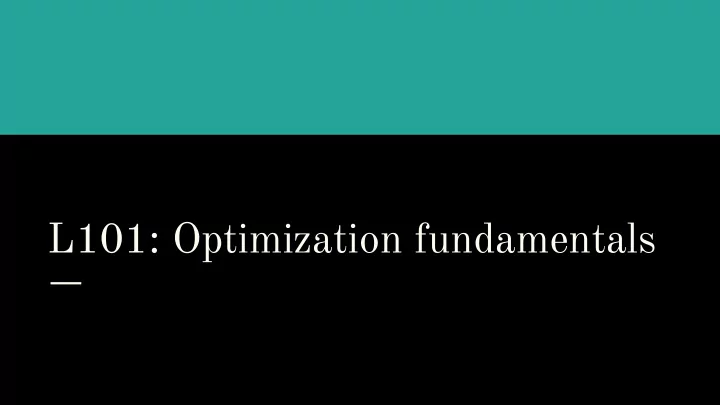

L101: Optimization fundamentals
Previous lecture Logistic regression parameter learning: Supervised machine learning algorithms typically involve optimizing a loss over the training data: This is an instance of numerical optimization , i.e. optimize the value of a function with respect to some parameters. A scientific field of its own; this lecture just gives some useful pointers
Types of optimization problems Continuous: Discrete: Sounds rare in NLP? Inference in classification/structured prediction: a label is either applied or not Constraints: Examples: SVM parameter training, enforcing constraints on the output graph
Convexity For sets: For functions: If f concave, -f is convex For sets the http://en.wikipedia.org/wiki/Convex_set, relation is more http://en.wikipedia.org/wiki/Convex_function complicated
Taylor’s theorem For a function f that is continuously differentiable, there is t such that: If twice differentiable: ● Given value and gradients, can approximate function elsewhere ● Higher degree gradient, better approximation
Types of optimization algorithms ● Line search ● Trust region ● Gradient free ● Constrained optimization
Line search At the current solution x k , pick a descent direction first p k , then find a stepsize α : and calculate the next solution: General definition of direction: Gradient descent: Newton method (assuming f twice differentiable and B k invertible):
Gradient descent (for supervised MLE training) To make it stochastic, just look at one training example in each iteration and go over each of them. Why is this a good idea? What can go wrong?
Gradient descent Wrong step size: https://srdas.github.io/DLBook/GradientDescentTechniques.html Line search converges to the minimizer when the iterates follow the Wolfe conditions on sufficient decrease and curvature (Zoutendijk’s theorem) Back tracking: start with a large stepsize and reduce it to get sufficient decrease Stochastic: noisy gradients (a single datapoint might be misleading)
Second order methods Using the Hessian (line search Newton’s method): Expensive to compute. Can we approximate? Yes, based on the first order gradients: -1 directly without moving too far from B k -1 BFGS calculates B k+1
What is a good optimization algorithm? Fast convergence: ● Few iterations ○ Stochastic gradient descent will have more than standard gradient descent ● Cheap iterations; what makes them expensive? ○ Function evaluations for backtracking with line search (this is the reason for researching adaptive learning rates) ○ (approximate) second order gradients Memory requirements? Storing second order gradients requires | w | 2 . One of the key variants of BFGS is L(imited memory)-BFGS. One can learn the updates: Learning to learn gradient descent by gradient descent
Trust region Taylor’s theorem: Assuming an approximation m to the function f we are minimizing: Given a radius Δ (max stepsize, trust region), choose a direction p such that: Measuring trust:
Trust region Worth considering with relatively few dimensions. Recent success in reinforcement learning
Gradient free What if we don’t have/want gradients? ● Function is a black box to us, can only test values ● Gradients too expensive/complicated to calculate, e.g.: hyperparameter optimization Two large families: ● Model-based (similar to trust region but without gradients for the approximation model) ● Sampling solutions according to some heuristic ○ Nelder-Mead ○ Evolutionary/genetic algorithms, particle swarm optimization
Bayesian Optimization ● Model approximation based on Gaussian Process regression ● Acquisition function tells us where to sample next Frazier (2018)
Constraints Reminder: Minimizing the Lagrangian function converts it to unconstrained optimization (for equality constraints, for inequalities it is slightly more involved): Example:
Overfitting A function (separating hyperplane) The training data https://en.wikipedia.org/wiki/Overfitting#Machine_learning
Regularization We want to optimize the function/fit the data but not too much: Some options for the regularizer: ● L2: Σ w 2 ● L1 (Lasso): Σ | w | ● Ridge: L1+L2 ● L-infinity: max( w )
Words of caution Sometimes we are saved from overfitting by not optimizing well enough There is often a discrepancy between loss and evaluation objective; often the latter are not differentiable (e.g. BLEU scores) Check your objectives if it tells you the right thing: optimizing less aggressively and getting better generalization is OK, having to optimize badly to get results is not. Construct toy problems: if you have a good initial set of weights, does your optimizing the objective leave them unchanged?
Harder cases ● Non-convex Saddle points: zero gradient is a first ● Non-smooth order necessary condition, not sufficient https://en.wikipedia.org/wiki/Saddle_point
Bibliography ● Numerical Optimization, Nocedal and Wright, 2002. (uncited images from there) https://www.springer.com/gb/book/9780387303031 ● On integer (linear) programming in NLP: https://ilpinference.github.io/eacl2017/ ● Francisco Orabona’s blog: https://parameterfree.com ● Dan Klein’s Lagrange Multipliers without Permanent Scarring
Recommend
More recommend